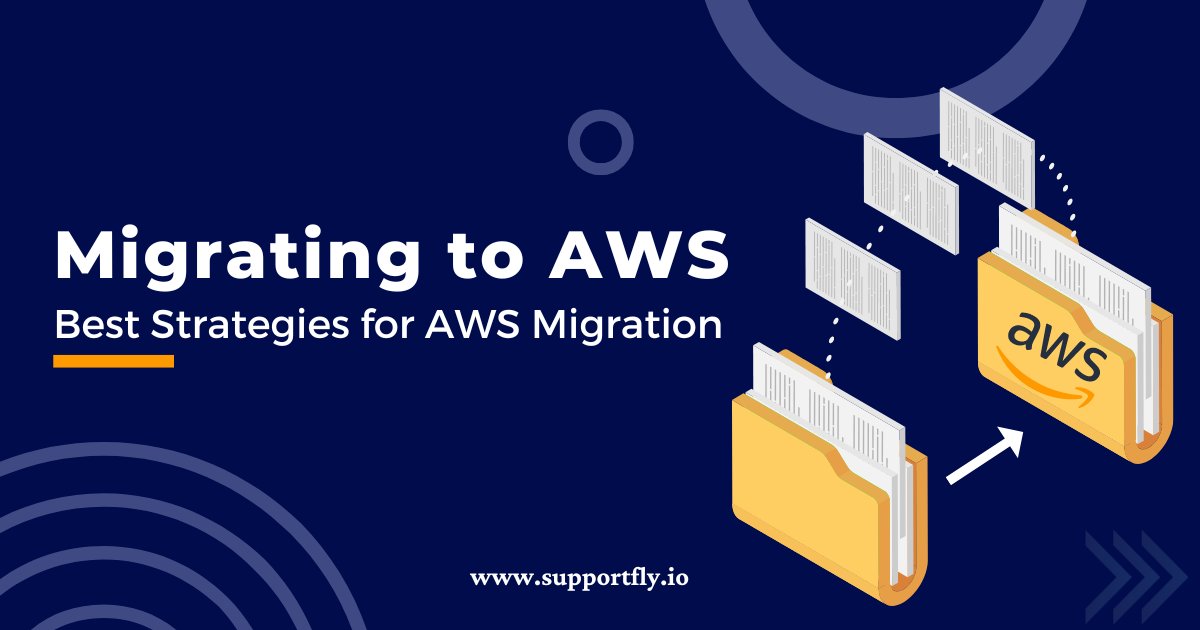Migrating to AWS: Best Strategies for AWS Migration
Migrating to AWS is one of an organization's most significant shifts. Many organizations need help knowing where to begin when migrating to AWS.

Migrating to AWS is one of an organization's most significant shifts. Many organizations need help knowing where to begin when migrating to AWS. Many fear that their data might leak, and others can't find the best strategies for AWS migration. Some people are concerned that they will go broke if they switch to AWS.
The involved migration strategy is a significant factor in all of these worries.
This guide will go over more than just AWS cloud migration strategies. It will also go over why you might want to migrate to AWS, the challenges you might face, and which method to use for which use case.
What is AWS Migration?
An Amazon Web Services (AWS) migration moves multiple workloads from an on-premises environment, a private cloud, or a public cloud to the infrastructure provided by AWS's public cloud. You can migrate websites and virtual servers and move applications, databases, and data centers.
Why Migrating To AWS?
AWS offers the most comprehensive cloud infrastructure currently available on the market, surpassing Azure Cloud Service and Google Cloud Platform (GCP), ranked second and third, respectively. In addition, it offers more experience in managing cloud infrastructure than most of its competitors. But that's not the end of it.
AWS benefits include:
- Cloud security. A move to AWS could reduce the risk of security breaches and other related events for an average company by 43 percent, according to a study conducted by IDC.
- Flexibility and use cases. Within these broad classes, other choices can be made. Amazon Elastic Compute Cloud (EC2), AWS Lambda, Amazon Elastic Container Service (EKS), and AWS Fargate are all examples of AWS compute services.
- Uptime. Amazon Web Services (AWS) guarantees 99.99% uptime and claims a 69% reduction in unscheduled outages.
- Cloud services options. Cloud storage, databases, computing, serverless computing, machine learning and artificial intelligence, networking, and automation are just a few more than 200 services AWS offers.
- Latency. AWS ensures that all workloads that require consistently low latency to run smoothly have access to it.
- Cost-efficiency. According to IDC, companies that use AWS can save 31% on infrastructure costs compared to those that use on-premises infrastructure. To assist users in lowering costs, AWS provides discount pricing options such as AWS Savings Plans, Spot instances, and Reserved Instances.
- Energy efficiency and sustainability. AWS is approximately 3.6 times more energy efficient than comparable-sized conventional data centers. While AWS is not yet carbon-neutral, it can help you reduce your data center energy bills.
- Server capacity. AWS provides nearly limitless server capacity businesses can buy, increase, or decrease on demand.
- Regular updates. AWS's many services are automatically updated regularly, so users never have to worry about keeping up.
- Expertise and support. Cloud specialists from Amazon Web Services (AWS) are more accessible than those from competing platforms.
- Suitability for SMEs. Regarding features, pricing, and customer support, AWS is the most accommodating platform for small and medium-sized businesses.
- Availability zones. AWS has the most significant footprint of the top three cloud providers, with 76 locations available in 24 regions (compared to approximately 60 for Microsoft Azure and about 33 for Google GCP).
- The AWS Free Tier provides six free services to assist new users in migrating to the AWS cloud infrastructure.
With so many advantages over competitors, you may want to migrate to AWS immediately. But why aren't all businesses migrating to the cloud — or, for that matter, AWS?
This is because it can be difficult.
What Are The Challenges Of Migrating To AWS?
Many businesses need help to transition to the cloud in stages. It necessitates meticulous planning, expertise, monitoring, and the secure, rapid, and uninterrupted transfer of massive data.
These are some additional challenges associated with moving to the cloud, some of which are unique to AWS migrations:
- It isn't easy to accurately estimate the time and money required for an AWS migration.
- Transferring workloads to AWS can be an expensive endeavor.
- Training internal teams to migrate successfully can be time-consuming but still fall short of requirements.
- Businesses need help to monitor the costs and progress of migration in real-time.
- It is only sometimes possible for businesses to have, find, or keep on staff experienced AWS migration experts who can oversee the entire process.
- Experts in cloud computing, data analysis, and cybersecurity could be in better supply than the demand for their services.
- Overwhelming engineering work can result from moving all of the workloads or a significant portion of them.
- When workloads are moved manually to the cloud, it can lead to performance and compatibility problems and security concerns.
- Migrating to an IaaS like Amazon Web Services (AWS), which does not have prescriptive guidelines for its use, can be more complex than moving to a PaaS.
- Businesses need help determining which workloads are responsible for most of the costs associated with cloud migration.
- During workload migration, many organizations have difficulty putting guardrails in place, which is necessary to prevent excessive spending.
To help organizations deal with these challenges, SupportFly offers AWS support services that make migrating to AWS a breeze. Our experts migrate all your data to the cloud securely and efficiently. Since we have been doing this for a while now, our experts can easily cut down all unnecessary expenses and reduce the cost of migrating to AWS. With AWS Support Services, SupportFly takes care of the entire migration process and offers AWS cloud support services so that you don't have to indulge in this complex procedure and focus on growing your business.
Now that you know why migrating to AWS is a good option for companies and what are the challenges they face when migrating to AWS, let's discuss the best strategies for AWS migration.
Best strategies for AWS migration
Here's a detailed description of the different AWS migration strategies:
Rehost (lift and shift): This strategy involves moving your applications to AWS without changing their architecture or code. It's the quickest and easiest way to migrate your applications to AWS. You can do this by replicating your existing cloud infrastructure using AWS services such as EC2, RDS, and S3. This approach can be helpful if you want to quickly move your applications to the cloud without incurring significant downtime or re-architecting.
However, this approach may not be the most cost-effective in the long term, as it may not take full advantage of the benefits of the cloud. Applications lifted and shifted to AWS may need to be more scalable, efficient, and cost-effective.
Replatform: This strategy involves modifying your applications to take advantage of AWS services while keeping the core architecture intact. For example, you might move your on-premise database to Amazon RDS or use Amazon S3 for storage. This approach can be helpful if you want to take advantage of cloud-native services and features that can help you reduce costs, improve scalability, and increase performance.
Replatforming can be more complex than rehosting, but it can be a good option if you have applications that need to be moved to the cloud quickly and with minimal downtime.
Repurchase: This strategy involves replacing your existing software with a SaaS solution already hosted in the cloud. This can be a good option if you want to move away from managing your infrastructure and focus on your core business activities. This approach can be helpful if you have applications nearing the end of their life cycle or are no longer meeting your needs.
However, it's important to note that repurchasing may only sometimes be the most cost-effective option. You may need to pay licensing and subscription fees for the new software.
Refactor: This strategy involves significantly changing your application architecture and codes to exploit cloud-native features and services. This can result in a more scalable, efficient, and cost-effective application. This approach can be helpful if you have applications that need to be optimized for the cloud.
Refactoring can be time-consuming and complex, but it can result in significant cost savings and performance improvements in the long term.
Retire: This strategy involves retiring any applications or services that are no longer needed, reducing the overall complexity of your infrastructure and saving on costs. This approach can be helpful if you have applications that are no longer being used or are redundant.
Hybrid: This strategy combines on-premise and cloud infrastructure to meet your business requirements. This can be a good option if legacy applications must move quickly to the cloud. Hybrid deployments can provide the best of both worlds, allowing you to take advantage of the scalability and flexibility of the cloud while still maintaining your on-premise infrastructure.
Conclusion
Choosing the right migration strategy for your specific needs and goals is essential. AWS provides various tools and resources to help you plan and execute your migration, including the AWS Migration Hub, AWS Application Discovery Service, and AWS Database Migration Service. Choose the strategy that best suits your requirements, and employ it with the utmost efficiency.
What's Your Reaction?




















